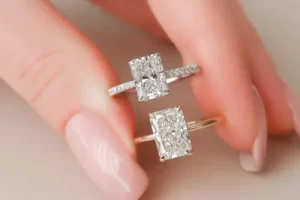Cubic zirconia (CZ) has become an increasingly popular alternative gemstone due to its visual similarity to diamonds coupled with its affordability and accessibility. However, what exactly is this synthetic stone that sparkles like a diamond but costs a fraction of the price?
This guide will unravel the mystery behind cubic zirconia by exploring how it is made, its properties and characteristics, how to identify it, and the reasons for its rising popularity.
What is Cubic Zirconia?
Cubic zirconia is a synthesized material that is designed to emulate the appearance of a diamond. It is composed of zirconium dioxide that has been stabilized with yttrium oxide and other elements to form a crystal structure that is optically flawless or near-flawless. This gives CZ the exceptional brilliance and fire for which diamonds are so highly prized.
Unlike a mined diamond that forms naturally deep within the Earth over billions of years under intense heat and pressure, cubic zirconia is produced rapidly under carefully controlled laboratory conditions. It can take as little as 2-3 days to grow a single CZ stone.
This accelerated technological process allows manufacturers to efficiently create affordable CZ stones in a variety of sizes, cuts, and colors. The technological precision also means that each stone can be crafted essentially flawless with an unmatched consistency during production.

Key Properties & Characteristics
Cubic zirconia has several key properties that set it apart from diamond and contribute to its physical attraction:
- Optical Properties
CZ has an exceptional refractive index (2.15-2.18) and dispersion rate, exceeding that of a diamond (2.42)[4]. This allows it to demonstrate tremendous brilliance and fire. Well-cut CZ can have up to 70% more facets than a diamond to capitalize on this optical effect.
- Hardness
On the Mohs scale, CZ receives a rating of 8 to 8.5, which approaches a diamond’s perfect 10 rating. This high hardness provides durability for jewelry usage.
- Faceting
Its crystal structure allows CZ to be expertly faceted and polished for maximum optical performance. Precise faceting enhances its refractive qualities.
- Color Variety
Unlike diamonds which occur in nature in mostly white/clear or yellowish hues, quality CZ can be manufactured readily in almost any color and shade imaginable. This diversity allows consumers to customize a stone’s color to align with their preferences.
- Affordability
High gemological qualities coupled with efficient technological manufacturing has made quality CZ exceptionally affordable and available compared to diamond. Clear white CZ can retail 1% of the cost of a diamond. This had greatly expanded consumer access.

How to Identify Cubic Zirconia
While CZ can impressively mimic a diamond’s brilliance and fire in an affordable package, there are some techniques that can distinguish these two stones:
- Professional Appraisal
A professional jeweler or gemologist has the expert knowledge and specialized tools to identify CZ from diamond, including differences in chemical structure, crystal patterns, and more. They help advise customers understand what stone they possess.
- Light Performance
CZ and diamonds appear similar in diffused or dim lighting. However, Cubic Zirconia demonstrates enhanced sparkle and rainbow flashes in bright direct sunlight or spotlighting. The difference can be more noticeable under such conditions.
- Weight Difference
CZ tends to be lighter than diamond of equivalent size. Discerning a stone’s actual weight and dimensions can hint at its composition.
- UV Lighting
Under ultraviolet lighting, CZ will glow or fluoresce bright blue/purple while diamond shows little to no fluorescence. This fluorescent signature can assist with identification.
- Thermal Conductivity
Diamond is exceptionally conductive. Cubic Zirconia on the other hand will quickly become warm to the touch under conditions like bright lighting. Sensitivity to heat helps determine the stone.

Rising Popularity of Cubic Zirconia
What has driven cubic zirconia’s rising prominence and popularity as an accessible alternative gemstone? Several socioeconomic factors help explain its expanding appeal:
- Increased Production Efficiency
Manufacturing methods have rapidly improved to allow CZ creation faster and more affordably without sacrificing optical quality. Production costs have dropped considerably.
- Focus on Conscious Consumerism
Younger generations especially have an enhanced focus on value, accessibility, and responsible spending habits. CZ can satisfy the desire for diamond’s allure at a reasonable price point.
- Elevated Laboratory Standards
Enhancements in laboratory growing methods and quality assurance testing allows CZ to better compete aesthetically with mined diamonds. Advancements continue to minimize visual differences.
- Customization Options
The level of customization possible with CZ regarding size, cut, color and more was previously unattainable with diamond for most. Personalized designs aligned with consumer taste helps drive CZ selection.
- Ethical Mining Concerns
Increased attention on ethical mining practices and sourcing with diamonds has led some consumers to explore more socially-conscious CZ alternatives.

So in summary, cubic zirconia provides an affordable and customizable option that can mimic diamond’s most desirable attributes like brilliance and fire. While differences exist between the natural and synthetic gems, steady advancements in CZ manufacturing and rising economic factors explains its surging popularity as an diamond alternative that consumers can responsibly feel proud of.


great points altogether, you simply gained a brand new reader. What would you recommend about your post that you made a few days ago? Any positive?